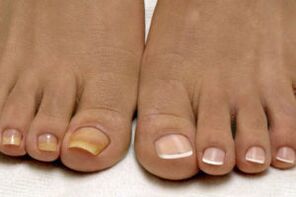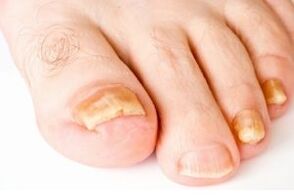Toenail fungus, or also called onychomycosis, is a very common disease that is spread by contact. It is caused by epidermal fungi, which are actually pathogenic microorganisms. After entering human skin, the fungus affects the upper layer of the epidermis of the foot and the nail plate. In addition to causing aesthetic discomfort, this disease can also lead to complications if left untreated for a long time.
main symptoms of the disease

Before deciding how to get rid of nail fungus, you should make sure the diagnosis is correct. There is a complex of symptoms that are only characteristic of this disease. It includes the following flags:
- Change the usual color of the nail plate to white, yellow, green, gray or even black;
- itchy feeling between the toes, on the feet;
- brittle and falling nails;
- Irritated skin on the legs that may peel, blisters, or ulcers;
- Abnormal thickening and unevenness of the nail plate.
In the initial stages of the disease, nail fungus appears almost imperceptibly. After all, some people may not even notice the slight itching and slight discoloration. But if you don't get rid of toenail fungus in time, it can lead to complete destruction of the plate. Therefore, it is important to contact a specialist immediately when worrisome symptoms develop. This will help remove the fungus quickly and restore the nails to their former healthy state.
Drug treatment of mycosis

Using medication is an effective way to get rid of nail fungus quickly. A large number of drugs are now released in different forms. The most common of these are:
- Medicinal varnishes - their use is effective only at the initial stage, when the fungus does not have time to spread to the growth lines of the nail plate. These funds are very simple to use and very effective in helping to get rid of the disease in a short period of time;
- Ointments and creams are the most common topical preparations. With these tools, you can remove the fungus that grows under your nails. Due to their texture, creams and ointments coat the affected area and help not only stop the progression of mycosis but also tissue regeneration;
- Pills - Unfortunately, the fungus not only affects the nails, but often negatively affects the state of the body's immune system. Medications that should be taken by mouth help to forget about the disease for a long time. It should be understood, however, that they can negatively affect the function of the gastrointestinal tract.
Treating Fungus with Vinegar
Acetic acid will help get rid of nail fungus at home. This method is one of the most common in traditional medicine. The implication is that epidermal fungi die under the influence of an acidic environment. For best results, it is necessary to dilute the vinegar with water to the correct ratio. When fighting nail fungus at home, a low-concentration acidic solution is sufficient.
You should clean and steam the skin of your legs prior to the procedure. Dead and fungal nail areas should be removed with small scissors. This will allow the acid to penetrate deeper. There are several ways to get rid of nail fungus with vinegar, including:
- Bath - The 9% vinegar solution must be heated to a temperature of about 36-37 degrees. Immerse the affected finger in the warm liquid for 15 minutes. Do not rub your feet or rinse with water after surgery;
- Compression - You should fold the bandage a few times and moisten it with plenty of vinegar. This compression is then applied to the affected area. For better results, wrap your legs with bandages, put on thermal socks, and leave them overnight;
- Ointment - Vinegar can be used as a component of the medicine, for example, it can be mixed with vegetable oil and dimethyl phthalate in equal proportions. Apply this mixture before bed.
In addition to treating lesions with vinegar, special attention should be paid to the patient's shoes. It must be wiped with a slightly acidic solution on a regular basis.
Treating fungi with iodine
Iodine solutions are great for nail fungus. It has antiseptic properties, so it is often used to disinfect affected skin areas. Additionally, iodine has cauterizing properties, which are important in preventing further spread of infection. It is sometimes used for preventive purposes.
To understand how to treat toenail fungus with iodine, you should understand its mechanism of action on mycosis cells. In fact, the work of the solution is based on the coagulation (coagulation) of the protein. Based on the fact that fungal cells have a protein structure, iodine enters the affected areas, destroying them and preventing further spread. It is through this that complete healing occurs.
You can use iodine to fight toenail fungus in several ways:
- Dotted line - apply the agent directly to the site of infection. In this case, the probability of a quick recovery is very high.
- Bath - Add iodine to clean boiling water, then soar your legs for 10 minutes. This method can be used for disease prevention. After all, it's easier to prevent problems than to think about how to get rid of the fungus later.
other folk remedies
Alternative medicine is very popular right now. Therefore, there are many recipes that will help ease the course of the disease and ensure a quick recovery. When fighting nail fungus, the following methods are most commonly used:
- Tar soap - has antibacterial properties. For medicinal purposes, it is used by lathering on the affected area. For efficiency, you can put on warm socks and leave it overnight;
- Tea tree oil is a powerful natural preservative. This method is best used in combination with other methods to speed up recovery. The oil can be used in baths, compresses or lotions;
- Garlic is a very simple yet very effective remedy. After a week of routine procedures, the results will be noticeable. Garlic porridge should be smeared on the lesion or compress with its juice;
- Celandine - usually bathed with a herbal infusion. The procedure must be repeated every two days until the symptoms of the disease have completely disappeared;
- Kombucha - it is used as a lotion. Where your fingers are sore, you should place a small piece of peroxide mushroom and secure it with film. This remedy has a softening effect. After surgery, you can easily trim off the affected nail;
- Use Smoke - Fumigate sore fingers with the smoke from cotton fabrics. Thanks to the procedure, the nails affected by mycosis fall off after a while and healthy nails grow in their place;
- Propolis - used as a compressed infusion. To prepare it, mix alcohol and ground propolis. After infusing the mixture, apply it to a clean gauze and wrap it around the sore finger.
Toenail fungus often appears for no apparent reason. It brings great inconvenience to people's lives. Therefore, you should not delay its treatment for a long time. To learn how to get rid of toenail fungus, you should consult a dermatologist. It will help you choose those funds that will have a quick and positive impact.















